Standards Worldwide
Standards Worldwide
Phone +49 30 58885700-07

Standard [CURRENT]
ASTM C 829:1981
Standard Practices for Measurement of Liquidus Temperature of Glass by the Gradient Furnace Method
- German title
- Messung der Liquidustemperatur von Glas mit dem Brennofen
- Publication date
- 1981 reapproved: 2022
- Original language
- English
- Pages
- 9
- Publication date
- 1981 reapproved: 2022
- Original language
- English
- Pages
- 9
- DOI
- https://dx.doi.org/10.1520/C0829-81R22
Product information on this site:
Quick delivery via download or delivery service
Buy securely with a credit card or pay upon receipt of invoice
All transactions are encrypted
Short description
1.1 These practices cover procedures for determining the liquidus temperature (Note 1) of a glass (Note 1) by establishing the boundary temperature for the first crystalline compound, when the glass specimen is held at a specified temperature gradient over its entire length for a period of time necessary to obtain thermal equilibrium between the crystalline and glassy phases. Note 1 -These terms are defined in Terminology C162. 1.2 Two methods are included, differing in the type of sample, apparatus, procedure for positioning the sample, and measurement of temperature gradient in the furnace. Both methods have comparable precision. Method B is preferred for very fluid glasses because it minimizes thermal and mechanical mixing effects. 1.2.1 Method A employs a trough-type platinum container (tray) in which finely screened glass particles are fused into a thin lath configuration defined by the trough. 1.2.2 Method B employs a perforated platinum tray on which larger screened particles are positioned one per hole on the plate and are therefore melted separately from each other. 1.3 This standard does not purport to address all of the safety concerns, if any, associated with its use. It is the responsibility of the user of this standard to establish appropriate safety and health practices and determine the applicability of regulatory limitations prior to use.
ICS
81.040.10
DOI
https://dx.doi.org/10.1520/C0829-81R22
Also available in
Loading recommended items...
Loading recommended items...
Loading recommended items...
Loading recommended items...
